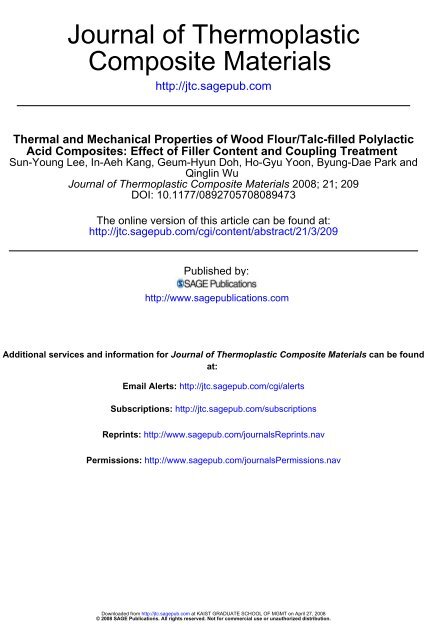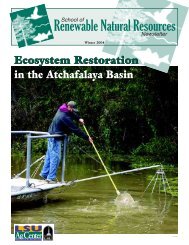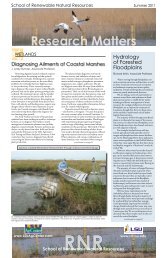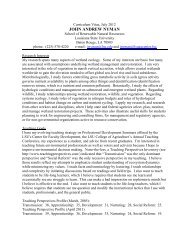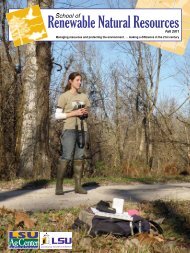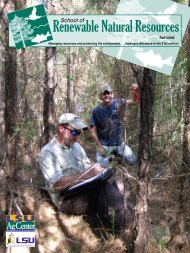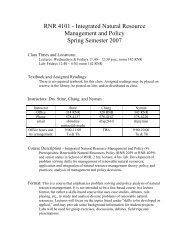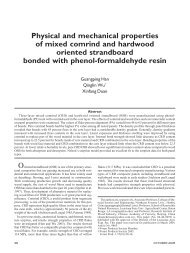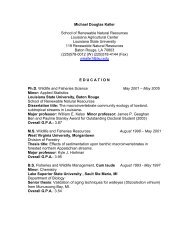Composite Materials Journal of Thermoplastic - LSU School of ...
Composite Materials Journal of Thermoplastic - LSU School of ...
Composite Materials Journal of Thermoplastic - LSU School of ...
You also want an ePaper? Increase the reach of your titles
YUMPU automatically turns print PDFs into web optimized ePapers that Google loves.
<strong>Journal</strong> <strong>of</strong> <strong>Thermoplastic</strong><br />
<strong>Composite</strong> <strong>Materials</strong><br />
http://jtc.sagepub.com<br />
Thermal and Mechanical Properties <strong>of</strong> Wood Flour/Talc-filled Polylactic<br />
Acid <strong>Composite</strong>s: Effect <strong>of</strong> Filler Content and Coupling Treatment<br />
Sun-Young Lee, In-Aeh Kang, Geum-Hyun Doh, Ho-Gyu Yoon, Byung-Dae Park and<br />
Qinglin Wu<br />
<strong>Journal</strong> <strong>of</strong> <strong>Thermoplastic</strong> <strong>Composite</strong> <strong>Materials</strong><br />
2008; 21; 209<br />
DOI: 10.1177/0892705708089473<br />
The online version <strong>of</strong> this article can be found at:<br />
http://jtc.sagepub.com/cgi/content/abstract/21/3/209<br />
Published by:<br />
http://www.sagepublications.com<br />
Additional services and information for <strong>Journal</strong> <strong>of</strong> <strong>Thermoplastic</strong> <strong>Composite</strong> <strong>Materials</strong> can be found<br />
at:<br />
Email Alerts: http://jtc.sagepub.com/cgi/alerts<br />
Subscriptions: http://jtc.sagepub.com/subscriptions<br />
Reprints: http://www.sagepub.com/journalsReprints.nav<br />
Permissions: http://www.sagepub.com/journalsPermissions.nav<br />
Downloaded from http://jtc.sagepub.com at KAIST GRADUATE SCHOOL OF MGMT on April 27, 2008<br />
© 2008 SAGE Publications. All rights reserved. Not for commercial use or unauthorized distribution.
Thermal and Mechanical Properties<br />
<strong>of</strong> Wood Flour/Talc-filled Polylactic<br />
Acid <strong>Composite</strong>s: Effect <strong>of</strong> Filler<br />
Content and Coupling Treatment<br />
SUN-YOUNG LEE, 1, *IN-AEH KANG, 1 GEUM-HYUN DOH, 1<br />
HO-GYU YOON, 2 BYUNG-DAE PARK 3 AND QINGLIN WU 4<br />
1 Division <strong>of</strong> Environmental Material Engineering<br />
Department <strong>of</strong> Forest Products, Korea Forest Research Institute<br />
Hoegi-Ro 57, Dongdaemun-Gu, Seoul 130-712, Korea<br />
2 Department <strong>of</strong> Material Science and Engineering<br />
Korea University, Anam-Dong, Seongbuk-Gu, Seoul 136-701, Korea<br />
3 Department <strong>of</strong> Forest Products, Kyungpook National University<br />
1370 Sankyuk-Dong, Buk-Gu, Daegu 702-701, Korea<br />
4 <strong>School</strong> <strong>of</strong> Renewable Natural Resources, Louisiana State University<br />
Agricultural Center, Baton Rouge, LA 70803, USA<br />
ABSTRACT: Wood flour (WF) and talc-filled polylactic acid (PLA) composites are<br />
prepared by melt compounding and injection molding. The effects <strong>of</strong> filler loading<br />
and silane treatment, the thermal and mechanical properties <strong>of</strong> the composites are<br />
studied. Loading <strong>of</strong> WF and WF/talc mixture into neat PLA results in a small<br />
decrease in the glass transition and crystalline temperatures <strong>of</strong> the composites. The<br />
use <strong>of</strong> WF, talc and silane in the composites causes successively larger decreased in<br />
the composite crystallinity. The addition <strong>of</strong> talc and silane to PLA/WF composites<br />
improved the tensile modulus. The tensile strength <strong>of</strong> the composites decreases<br />
slightly with the addition <strong>of</strong> talc, but it considerably improves with the use <strong>of</strong> 1 wt%<br />
silane. Morphological analysis shows improved interfacial bonding with silane<br />
treatment for the composites.<br />
KEY WORDS: polymer composites, coupling, PLA, talc, wood flour.<br />
*Author to whom correspondence should be addressed. E-mail: nararawood@forest.go.kr<br />
<strong>Journal</strong> <strong>of</strong> THERMOPLASTIC COMPOSITE MATERIALS, Vol. 21—May 2008 209<br />
0892-7057/08/03 0209–15 $10.00/0 DOI: 10.1177/0892705708089473<br />
ß SAGE Publications 2008<br />
Los Angeles, London, New Delhi and Singapore<br />
Downloaded from http://jtc.sagepub.com at KAIST GRADUATE SCHOOL OF MGMT on April 27, 2008<br />
© 2008 SAGE Publications. All rights reserved. Not for commercial use or unauthorized distribution.
210 S.-Y. LEE ET AL.<br />
INTRODUCTION<br />
THE USE OF lignocellulosic materials and polymers from renewable<br />
resources has recently attracted increasing attention, predominantly due<br />
to environmental concerns and the depletion <strong>of</strong> petroleum resources [1–3].<br />
In general, polymers from renewable resources can be categorized into<br />
natural polymers such as starch [4–6], protein and cellulose [7–9], and<br />
synthetic polymers [10–12]. The development <strong>of</strong> synthetic polymers using<br />
monomers from natural resources provides a new direction for the<br />
development <strong>of</strong> biodegradable polymers.<br />
The most common biodegradable synthetic polymers are aliphatic<br />
polyesters such as polylactic acid (PLA), polyglycolic acids (PGA),<br />
polycaprolactone (PCL), and polyhydroxybutyrate (PHB). Among these<br />
biopolymers, PLA as biodegradable aliphatic polyester is <strong>of</strong> increasing<br />
commercial interest, because <strong>of</strong> its desired mechanical strength, thermal<br />
plasticity, and biocompatibility [13,14]. PLA has been used for many<br />
applications including grocery and composting bags, automobile panels,<br />
textiles, and bio-absorbable medical materials [15,16]. PLA is generally more<br />
expensive than many petroleum-derived commodity polyolefins such as<br />
polypropylene (PP) and polyethylene (PE). However, its price has been<br />
falling recently as more biopolymer production comes on-line [17].<br />
The compounding <strong>of</strong> fillers obtained from various sources into polymer<br />
matrices has been a well-accepted process to enhance mechanical and thermal<br />
properties <strong>of</strong> materials [1,2,18]. Wood flour (WF) and talc are two commonly<br />
used fillers for wood plastic composites (WPCs) [19,20]. The use <strong>of</strong> WF can<br />
reduce material costs and provide specific properties such as low density, high<br />
specific stiffness, and biodegradability [21–24]. In particular, WPCs with<br />
50 wt% or less plastic by weight, have been accepted by the construction<br />
industry and homeowners, largely for decking, fencing, ro<strong>of</strong>ing, window<br />
pr<strong>of</strong>ile, and automotives [21]. Talc (up to 30% by weight) can have a positive<br />
influence on modulus, strength, processing efficiency, creep and elastic recovery<br />
performance <strong>of</strong> WPCs [25]. A combination <strong>of</strong> organic (e.g., wood) and<br />
inorganic (e.g., talc) fillers in PLA may lead to interesting composite properties.<br />
In the intricate structure and morphology <strong>of</strong> polymer reinforced by<br />
organic and/or inorganic fillers, there is a problem related to the character<br />
and extent <strong>of</strong> interaction at the polymer-filler interfaces [21]. The established<br />
procedure for improving the interfacial adhesion <strong>of</strong> polymer and wood fiber<br />
is the use <strong>of</strong> coupling agent, resulting in a good chemical and/or physical<br />
bonding between polymer matrix and particle surfaces [26]. For example,<br />
various types <strong>of</strong> silanes have been developed to promote the interfacial<br />
adhesion. Organo-functional silanes are used to couple organic polymers<br />
with inorganic materials such as talc, silica, and mica [27].<br />
Downloaded from http://jtc.sagepub.com at KAIST GRADUATE SCHOOL OF MGMT on April 27, 2008<br />
© 2008 SAGE Publications. All rights reserved. Not for commercial use or unauthorized distribution.
Thermal and Mechanical Properties <strong>of</strong> WF/Talc-filled PLA <strong>Composite</strong>s 211<br />
Most <strong>of</strong> the polymer composites are generally subjected to a thermal<br />
degradation at elevated temperatures. It is important to understand the<br />
effects <strong>of</strong> the processing temperature on the thermal degradation process,<br />
since there is constant thermal stress during the manufacturing <strong>of</strong> filler<br />
reinforced composites. Fundamental information regarding the thermal<br />
stability <strong>of</strong> natural fiber reinforced composites has been obtained from<br />
thermogravimetric analysis (TGA) and differential scanning calorimetry<br />
(DSC) [28]. Additional information on the thermal and mechanical properties<br />
can shed more light on the manufacture <strong>of</strong> the composite materials.<br />
The objective <strong>of</strong> this study was to investigate the effects <strong>of</strong> WF and talc<br />
loading and silane treatment on thermal, mechanical and morphological<br />
properties <strong>of</strong> the PLA-based composites. TGA, DSC, scanning electron<br />
microscopy (SEM), and stress–strain behavior were used to evaluate the<br />
thermal degradation, thermal transition, morphological, and mechanical<br />
properties <strong>of</strong> the composites.<br />
<strong>Materials</strong><br />
MATERIALS AND METHODS<br />
Polylactic acid (2100D, M w ¼ 180,000–210,000 g/mol and MI ¼ 5–15 g/<br />
10 min) was obtained from the Natureworks Õ Co. (Minnetonka, U.S). Wood<br />
flour (Lignocel C120, particle size <strong>of</strong> 100–120 mesh per 2.54 cm 2 ) was supplied<br />
by J. Retenmaier & Sohne Co. (Rosenberg, Germany) and manufactured<br />
from European s<strong>of</strong>twood. Talc powder supplied from Seobu Enterprise<br />
Co. (Goyang-City, Republic <strong>of</strong> Korea) has a chemical structure <strong>of</strong><br />
Mg 3 Si 4 O 10 (OH) 2 and melting point <strong>of</strong> 900 10008C. Average particle size<br />
and density <strong>of</strong> talc were 2 mm and 2.5–2.8 g/cm 3 , respectively. Organo-silane<br />
(S-6020, H 2 N(CH 2 ) 2 NH 2 (CH 2 ) 3 Si(OCH 3 ) 3 ) was purchased from the Dow<br />
Corning Co. (Midland, Michigan, U.S.A.). The molecular weight and a<br />
density <strong>of</strong> the silane at 258C are 222 g/mol and 1.03 g/cm 3 , respectively.<br />
Melt Compounding<br />
A 19 mm co-rotating twin-screw extruder with 40 L/D ratio (Bautek Co.,<br />
Uijungbu-City, Korea) a pelletizer (Bautek Co., Uijungbu-city, Korea) was<br />
used to compound the blends. Table 1 shows blend formulations <strong>of</strong> the<br />
composites used in this study. Silane was simply integral-blended with<br />
other components without any additional treatment. The compounding<br />
temperature was 1808C with screw speeds in the range <strong>of</strong> 100–150 rpm. The<br />
extrudated strands were air-cooled and pelletized with a pelletizer<br />
(Uijungbu-city, Bautek Co., Korea). The hybrid pellets were dried at 908C<br />
Downloaded from http://jtc.sagepub.com at KAIST GRADUATE SCHOOL OF MGMT on April 27, 2008<br />
© 2008 SAGE Publications. All rights reserved. Not for commercial use or unauthorized distribution.
212 S.-Y. LEE ET AL.<br />
Table 1. Material formulations <strong>of</strong> the hybrids.<br />
PLA (wt%) WF (wt%) Talc (wt%) Silane (wt%)<br />
100 0 – –<br />
90 10 – –<br />
80 20 – –<br />
70 30 – –<br />
60 40 – –<br />
80 10 10 –<br />
70 20 10 –<br />
60 30 10 –<br />
50 40 10 –<br />
79 and 77 10 10 1 and 3<br />
69 and 67 20 10 1 and 3<br />
59 and 57 30 10 1 and 3<br />
49 and 47 40 10 1 and 3<br />
for 24 h in a vacuum oven to remove the absorbed moisture and cooled to<br />
room temperature, and then injection-molded at 1908C to form test samples.<br />
Thermal Analysis<br />
The thermal decomposition behavior <strong>of</strong> the composites was measured<br />
with a SDT Q600 Thermogravimetric analyzer (TA Instrument Inc., USA).<br />
Tests were done under nitrogen at a heating rate <strong>of</strong> 108C/min over a<br />
temperature range <strong>of</strong> 30–6008C. A sample <strong>of</strong> 5–10 mg was used for each run.<br />
The weight change was recorded as a function <strong>of</strong> heating temperature.<br />
Differential peak temperature (DT p ) was defined as the temperature <strong>of</strong> the<br />
maximum derivative <strong>of</strong> the weight change over time. DSC experiments were<br />
performed in a Q10 differential scanning calorimeter (TA Instrument Inc.,<br />
USA). Each sample was heated and cooled at a heating rate <strong>of</strong> 108C/min<br />
under nitrogen atmosphere. Each test sample <strong>of</strong> 5–10 mg was placed in an<br />
aluminum pan and heated from 30 to 2008C and then cooled down to 308C<br />
after keeping at 2008C for 3 min. The glass transition temperature (T g ),<br />
melting temperature (T m ), melting enthalpy (H m ), and crystallinity (X c )<br />
were determined from the first heating scan, while the crystallization<br />
temperature (T c ) and crystallization enthalpy (H c ) were obtained from the<br />
first cooling scan. T m is defined as the maximum <strong>of</strong> the endothermic melting<br />
peak and T g as the deflection <strong>of</strong> the baseline temperature from the first<br />
heating scan. The X c was obtained by the following expression:<br />
X c ð%Þ ¼<br />
H m<br />
H mðcrysÞ<br />
100<br />
ð1Þ<br />
Downloaded from http://jtc.sagepub.com at KAIST GRADUATE SCHOOL OF MGMT on April 27, 2008<br />
© 2008 SAGE Publications. All rights reserved. Not for commercial use or unauthorized distribution.
Thermal and Mechanical Properties <strong>of</strong> WF/Talc-filled PLA <strong>Composite</strong>s 213<br />
where H m is the enthalpy <strong>of</strong> the sample and H m(crys) is the enthalpy <strong>of</strong><br />
100% crystalline PLA taken as 93.7 J/g [5]. The H m , H c , and X c were<br />
converted by the mass fraction <strong>of</strong> the pure PLA in the composites.<br />
Mechanical Properties<br />
The tensile test for the composites was performed according to ASTM<br />
D638 using a Zwick an Universal Testing Machine (Zwick Testing Machine<br />
Ltd., Leomister, United Kingdom). Test specimens were molded to a size <strong>of</strong><br />
3.18 mm (width) 9.53 mm (length) 3.00 mm (thickness) with a gauge<br />
length <strong>of</strong> 12.5 mm. For each treatment level, five replicates were tested and<br />
the results were presented as the average <strong>of</strong> the tested samples. Tensile<br />
deformation was determined using an extensometer at a crosshead speed <strong>of</strong><br />
10 mm/min.<br />
Morphological Properties<br />
Morphology <strong>of</strong> the fractured composites after tensile testing was observed<br />
using a scanning electron microscope (SEM) (JEOL-6700F) with a field<br />
emission gun and an accelerating voltage <strong>of</strong> 5 kV. A gold layer <strong>of</strong> a few<br />
nanometers in thickness was coated onto the fracture surfaces. The samples<br />
were scanned perpendicular to the fractured surface. SEM micrographs were<br />
taken at the magnification level <strong>of</strong> 200.<br />
RESULTS AND DISCUSSION<br />
Thermal Properties<br />
TGA DATA<br />
TGA results <strong>of</strong> PLA, WF, and their composites are shown in Figure 1(a).<br />
As the WF content increased, the decomposition temperature <strong>of</strong> the PLA/WF<br />
composites decreased slightly. This may be due to the decomposition <strong>of</strong> wood<br />
components in a temperature range between 200 and 3808C. Cellulose and<br />
hemicellulose components <strong>of</strong> WF are two major contributors to the<br />
decomposition between 2008C and 3808C, whereas lignin is responsible for<br />
the char formation over 3808C [29]. The lower decomposition temperatures <strong>of</strong><br />
PLA/WF composites indicated that the composites were less thermally stable<br />
than the neat PLA matrix. Poor interfacial adhesion between the PLA matrix<br />
and WF due to incompatibility <strong>of</strong> hydrophobic PLA with hydrophilic WF<br />
might contribute to this behavior. Tar and ash content after thermal<br />
degradation over 3808C increased with an increase in the WF loading level.<br />
The differential peak temperatures (DT p ), as a function <strong>of</strong> WF loading for<br />
various systems are shown in Figure 1(b). The DT p <strong>of</strong> neat PLA was<br />
Downloaded from http://jtc.sagepub.com at KAIST GRADUATE SCHOOL OF MGMT on April 27, 2008<br />
© 2008 SAGE Publications. All rights reserved. Not for commercial use or unauthorized distribution.
214 S.-Y. LEE ET AL.<br />
(a)<br />
100<br />
80<br />
Weight change (%)<br />
60<br />
40<br />
PLA<br />
PLA90/WF10<br />
20<br />
PLA80/WF20<br />
PLA70/WF30<br />
PLA60/WF40<br />
WF<br />
0<br />
200 300 400 500 600<br />
(b)<br />
DT p (˚C)<br />
370<br />
350<br />
330<br />
Temperature (°C)<br />
PLA/WF<br />
PLA/WF/Talc10%<br />
PLA/WF/Talc10%/Silane1%<br />
PLA/WF/Talc10%/Silane3%<br />
310<br />
0 10 20 30 40<br />
Wood flour (%)<br />
Figure 1. Thermogravimetric properties <strong>of</strong> the composites: (a) TGA thermograms <strong>of</strong><br />
PLA/wood flour composites; and (b) Differential peak temperature <strong>of</strong> PLA/wood flour/talc/<br />
silane composites.<br />
358.28C, and the DT p <strong>of</strong> the PLA/WF composites ranged from 8 to 248C<br />
lower than that <strong>of</strong> neat PLA. The addition <strong>of</strong> talc to PLA/WF composites<br />
showed no significant effect on the thermal decomposition process. The<br />
loading <strong>of</strong> talc at 10 wt% level caused a slight shift <strong>of</strong> TGA curves. The DT p<br />
values <strong>of</strong> composites with talc ranged from 0 to 7.58C lower than those <strong>of</strong><br />
composites without talc. For example, the DT p values <strong>of</strong> PLA80/WF20<br />
Downloaded from http://jtc.sagepub.com at KAIST GRADUATE SCHOOL OF MGMT on April 27, 2008<br />
© 2008 SAGE Publications. All rights reserved. Not for commercial use or unauthorized distribution.
Thermal and Mechanical Properties <strong>of</strong> WF/Talc-filled PLA <strong>Composite</strong>s 215<br />
composite and PLA70/WF20/talc10 composite were 348.0 and 340.58C,<br />
respectively. The thermal decomposition temperatures <strong>of</strong> PLA/WF/talc<br />
composites with 1 wt% silane were higher, compared to those <strong>of</strong> the<br />
composites with 3 wt% silane.<br />
At higher levels <strong>of</strong> WF, the DT p values <strong>of</strong> the composites with 1 wt%<br />
silane were 2–48C higher than those with 3 wt% silane. The incorporation <strong>of</strong><br />
silane to PLA/WF/talc decreased the DT p by 27–398C compared to that <strong>of</strong><br />
neat PLA.<br />
3.1.2. DSC DATA<br />
The glass transition temperature, T g as function <strong>of</strong> WF loading for<br />
various systems are shown in Figure 2(a). The T g <strong>of</strong> neat PLA was 63.48C.<br />
As the WF loading increased, double peaks were observed in DSC<br />
thermograms, and the T g decreased slightly (Figure 2(a)). For example,<br />
the T g <strong>of</strong> the composite with WF (40 wt%) to PLA (60 wt%) decreased<br />
about 2.58C from that <strong>of</strong> pure PLA. The use <strong>of</strong> talc (10 wt%) in PLA50%/<br />
WF40% composites largely lowered the T g <strong>of</strong> the hybrids (4.08C), compared<br />
to that <strong>of</strong> PLA60%/WF40% hybrid. At the WF loading <strong>of</strong> 10, 20, and<br />
30 wt%, the addition <strong>of</strong> 1 wt% silane to the PLA/WF/talc combinations led<br />
to higher T g values than those <strong>of</strong> the combinations with 3 wt% silane.<br />
Similar to DT p data, higher T g <strong>of</strong> the composites with 1 wt% silane could be<br />
ascribed to an improved interfacial adhesion between two materials (i.e.,<br />
polymer matrix and fillers). This result also indicated that the T g depends on<br />
molecular characteristics, composition, and compatibility <strong>of</strong> the components<br />
in the amorphous matrix [19]. The melting temperature, T m , as a function<br />
<strong>of</strong> WF loading is shown in Figure 2(b). The T m <strong>of</strong> the PLA was 164.58C.<br />
The loading <strong>of</strong> WF (10–40 wt%) to the PLA decreased the T m by 1.5–1.78C.<br />
A decrease in the melting temperature might be due to the presence <strong>of</strong> voids<br />
in the composites.<br />
The enthalpy H m <strong>of</strong> the PLA was 41.7 J/g (Figure 3(a)). The H m<br />
values for composites with increased WF loading from 10 to 40 wt%<br />
significantly decreased (as low as 11.4 J/g), indicating that less energy was<br />
required to melt the composites (Figure 3(a)). This phenomenon implies that<br />
thermal degradation <strong>of</strong> the polymer became easier upon the hybridization<br />
with WF. The addition <strong>of</strong> talc (10 wt%) and silane (1 and 3 wt%) to<br />
PLA/WF composites showed no significant effect on the T m and H m <strong>of</strong><br />
composites. This result suggested that the addition <strong>of</strong> talc had resulted in<br />
tertiary interfaces in the composites and the added silane acted as a<br />
dispersing agent in the interfaces.<br />
Figure 3(b) shows the T c , representing an exothermic peak due to<br />
the crystallization <strong>of</strong> the polymer matrix. The T c <strong>of</strong> neat PLA was 113.18C,<br />
and the incorporation <strong>of</strong> WF to the neat PLA slightly decreased the T c by<br />
Downloaded from http://jtc.sagepub.com at KAIST GRADUATE SCHOOL OF MGMT on April 27, 2008<br />
© 2008 SAGE Publications. All rights reserved. Not for commercial use or unauthorized distribution.
216 S.-Y. LEE ET AL.<br />
(a)<br />
Glass transition temp. (T g , °C)<br />
70<br />
65<br />
60<br />
55<br />
PLA/WF<br />
PLA/WF/Talc10%<br />
PLA/WF/Talc10%/Silane1%<br />
PLA/WF/Talc10%/Silane3%<br />
50<br />
0 10 20 30 40<br />
Wood flour (%)<br />
(b)<br />
170<br />
Melting temp. (˚C)<br />
168<br />
166<br />
164<br />
162<br />
160<br />
158<br />
156<br />
154<br />
152<br />
PLA/WF<br />
PLA/WF/Talc10%<br />
PLA/WF/Talc10%/Silane1%<br />
PLA/WF/Talc10%/Silane3%<br />
150<br />
0 10 20 30 40<br />
Wood flour (%)<br />
Figure 2. Differential scanning calorimetric properties <strong>of</strong> the composites (I): (a) Glass<br />
transition temperature <strong>of</strong> PLA/wood flour/talc/silane composites; and (b) Melting temperature<br />
<strong>of</strong> PLA/wood flour/talc/silane composites.<br />
about 2.0–4.28C for the resultant composites. However, the loading<br />
<strong>of</strong> 10 wt% talc to the PLA/WF composites had no significant effect on<br />
the T c . The addition <strong>of</strong> silane (1 and 3 wt%) to the PLA/WF/talc composites<br />
gave slightly lower T c values than those <strong>of</strong> other composites without silane.<br />
Downloaded from http://jtc.sagepub.com at KAIST GRADUATE SCHOOL OF MGMT on April 27, 2008<br />
© 2008 SAGE Publications. All rights reserved. Not for commercial use or unauthorized distribution.
Thermal and Mechanical Properties <strong>of</strong> WF/Talc-filled PLA <strong>Composite</strong>s 217<br />
(a)<br />
50<br />
Melting enthalpy ( H m , J/g)<br />
40<br />
30<br />
20<br />
10<br />
PLA/WF<br />
PLA/WF/Talc10%<br />
PLA/WF/Talc10%/Silane1%<br />
PLA/WF/Talc10%/Silane3%<br />
0<br />
0 10 20 30 40<br />
Wood flour(%)<br />
(b)<br />
120<br />
Crystallization temp. (T c , °C)<br />
118<br />
116<br />
114<br />
112<br />
110<br />
108<br />
106<br />
104<br />
PLA/WF<br />
PLA/WF/Talc10%<br />
PLA/WF/Talc10%/Silane1%<br />
PLA/WF/Talc10%/Silane3%<br />
102<br />
100<br />
0 10 20 30 40<br />
Wood flour (%)<br />
Figure 3. Differential scanning calorimetric properties <strong>of</strong> the composites (II): (a) Melting<br />
enthalpy <strong>of</strong> PLA/wood flour/talc/silane composites; and (b) Crystallization temperature <strong>of</strong><br />
PLA/wood flour/talc/silane composites.<br />
This result could be due to the presence <strong>of</strong> either WF or talc in the<br />
polymer matrix, which interfered the crystallization process <strong>of</strong> the PLA.<br />
The loading <strong>of</strong> 1 wt% silane to the PLA/WF/talc composites resulted<br />
in a similar or higher T c values than those <strong>of</strong> 3 wt% silane (Figure 3(b)).<br />
Downloaded from http://jtc.sagepub.com at KAIST GRADUATE SCHOOL OF MGMT on April 27, 2008<br />
© 2008 SAGE Publications. All rights reserved. Not for commercial use or unauthorized distribution.
218 S.-Y. LEE ET AL.<br />
This result could be due to an improved interfacial adhesion between the<br />
polymer matrix and fillers.<br />
Neat PLA had the highest H c (34.1 J/g) and X c (44.5%) values<br />
compared to PLA/WF composites. The H c decreased as the loading<br />
level <strong>of</strong> WF increased (Figure 4(a)). Obviously, this result could be<br />
attributed to the amount <strong>of</strong> PLA in the composites as the WF content<br />
increased. The application <strong>of</strong> 10 wt% talc to PLA/WF composites further<br />
decreased the H c . The large decrease in the X c <strong>of</strong> the composites with the<br />
addition <strong>of</strong> WF, talc and silane was observed in Figure 4(b). This may be<br />
caused by the partial inhibition effect <strong>of</strong> WF, talc and silane on polymer<br />
crystal formation.<br />
Mechanical Properties<br />
The tensile modulus <strong>of</strong> neat PLA was 1,346 MPa (Figure 5(a)). As WF<br />
levels increased, the tensile modulus was enhanced. With the WF loading<br />
levels increased from 10 to 40 wt%, the tensile modulus increased from 62.5 to<br />
169.5%. The tensile strength <strong>of</strong> neat PLA was 63 MPa (Figure 5(b)). For<br />
PLA/WF composites, the tensile strength increased 13.7, and 16.7, and 13.9%<br />
at the loading levels <strong>of</strong> 10, 20, and 30 wt% WF, respectively. At 40 wt% WF<br />
loading, PLA/WF composite had a similar tensile strength as the neat PLA.<br />
As shown in Figure 5(a), the addition <strong>of</strong> talc (10 wt%) to PLA/WF<br />
composites improved the tensile modulus by about 18.3 to 50.2%.<br />
In addition, the use <strong>of</strong> 1 and 3 wt% silane led to the higher tensile modulus<br />
<strong>of</strong> composites, compared to neat PLA and PLA/WF composites without<br />
silane treatment. As shown in Figure 5(b), the addition <strong>of</strong> talc (10 wt%) to<br />
PLA/WF composites resulted in a slightly lower tensile strength than neat<br />
PLA. At 10 wt% talc loading, the tensile strength slightly decreased as the<br />
WF level increased. The PLA50%/WF40%/talc10% composite showed an<br />
8.6% lower tensile strength than the PLA80%/WF10%/talc10% composite.<br />
In addition, PLA50%/WF40%/talc10% composite had a 10.7% lower<br />
tensile strength than neat PLA. The addition <strong>of</strong> 1 wt% silane to PLA/WF/<br />
talc composites improved the tensile strength considerably, which indicates<br />
that silane facilitates the chemical bonding between WF and PLA, and<br />
between inorganic filler and PLA. The tensile strength <strong>of</strong> PLA/WF/talc<br />
composites with 1 wt% silane was significantly greater than that <strong>of</strong> PLA/<br />
WF/talc composites with 3 wt% silane. As discussed earlier, the addition <strong>of</strong><br />
1 wt% silane was more effective to improve interfacial adhesion than the<br />
addition <strong>of</strong> 3 wt% silane. An improved interfacial adhesion could be<br />
explained by a mechanism shown in the following three steps;<br />
1st step: the formation <strong>of</strong> silanol (Si-OH) by hydrolysis, or R-Si-<br />
(OH) 3 þ MeOH.<br />
Downloaded from http://jtc.sagepub.com at KAIST GRADUATE SCHOOL OF MGMT on April 27, 2008<br />
© 2008 SAGE Publications. All rights reserved. Not for commercial use or unauthorized distribution.
Thermal and Mechanical Properties <strong>of</strong> WF/Talc-filled PLA <strong>Composite</strong>s 219<br />
(a)<br />
Crystallization enthalpy (∆H c , J/g)<br />
40<br />
35<br />
30<br />
25<br />
20<br />
15<br />
10<br />
5<br />
PLA/WF<br />
PLA/WF/Talc10%<br />
PLA/WF/Talc10%/Silane1%<br />
PLA/WF/Talc10%/Silane3%<br />
0<br />
0 10 20 30 40<br />
Wood flour (%)<br />
(b)<br />
50<br />
Crystallinity (%)<br />
45<br />
40<br />
35<br />
30<br />
25<br />
20<br />
15<br />
10<br />
5<br />
PLA/WF<br />
PLA/WF/Talc10%<br />
PLA/WF/Talc10%/Silane1%<br />
PLA/WF/Talc10%/Silane3%<br />
0<br />
0 10 20 30 40<br />
Wood flour (%)<br />
Figure 4. Differential scanning calorimetric properties <strong>of</strong> the composites (III): (a) crystalline<br />
enthalpy <strong>of</strong> PLA/wood flour/talc/silane composites; and (b) crystallinity <strong>of</strong> PLA/wood flour/<br />
talc/silane composites.<br />
2nd step: the reaction <strong>of</strong> silanol with OH-groups on the surface <strong>of</strong> talc, or<br />
R-Si-O-talc þ H 2 O<br />
3rd step: R-Si-O-talc þ PLA, then finally PLA-Si-O-talc þ WF þ R-Si-<br />
(OH) 3 þ H 2 O can be formed.<br />
Downloaded from http://jtc.sagepub.com at KAIST GRADUATE SCHOOL OF MGMT on April 27, 2008<br />
© 2008 SAGE Publications. All rights reserved. Not for commercial use or unauthorized distribution.
220 S.-Y. LEE ET AL.<br />
(a)<br />
Tensile modulus (MPa)<br />
2200<br />
1900<br />
1600<br />
1300<br />
PLA/WF<br />
PLA/WF/Talc10%<br />
PLA/WF/Talc10%/Silane1%<br />
PLA/WF/Talc10%/Silane3%<br />
1000<br />
0 10 20 30 40<br />
Wood flour (%)<br />
(b)<br />
90<br />
80<br />
70<br />
Tensile strength (MPa)<br />
60<br />
50<br />
40<br />
30<br />
PLA/WF<br />
20<br />
PLA/WF/Talc10%<br />
PLA/WF/Talc10%/Silane1%<br />
10<br />
PLA/WF/Talc10%/Silane3%<br />
0<br />
0 10 20 30 40<br />
Wood flour (%)<br />
Figure 5. Tensile properties <strong>of</strong> the composites: (a) tensile modulus; and (b) tensile strength.<br />
From the 3rd step, the main chemical component is PLA-Si-O-talc.<br />
In terms <strong>of</strong> tensile strength, remaining R-Si-(OH) 3 and R-Si-(OMe) 3 have<br />
an interaction with PLA and WF, interfering the bonding potential <strong>of</strong> PLA-<br />
Si-O-talc. Therefore, the tensile strength at 3 wt% silane was significantly<br />
lower than that at 1 wt% silane level.<br />
Downloaded from http://jtc.sagepub.com at KAIST GRADUATE SCHOOL OF MGMT on April 27, 2008<br />
© 2008 SAGE Publications. All rights reserved. Not for commercial use or unauthorized distribution.
Thermal and Mechanical Properties <strong>of</strong> WF/Talc-filled PLA <strong>Composite</strong>s 221<br />
(a)<br />
(b)<br />
(c)<br />
(d)<br />
Figure 6. SEM images <strong>of</strong> the composites: (a) PLA60%/WF40%; (b) PLA80%/WF20%;<br />
(c) PP60%/WF30%/Talc10%; (d) PLA59%/WF30%/Talc10%/silane1% composites.<br />
Morphological Properties<br />
The SEM photomicrographs <strong>of</strong> the composites with PLA (80% and<br />
60 wt%), WF (20 and 40 wt%), talc(10 wt%), and silane(1 wt%) prepared by<br />
the compounding are shown in Figure 6. The compounding method led to a<br />
uniform distribution <strong>of</strong> WF in the PLA matrix. The system without silane<br />
treatment showed a poor compatibility between the PLA matrix and WF.<br />
The surface <strong>of</strong> WF particle was believed to be delaminated from the PLA<br />
matrix, and micro-size voids were formed during tensile testing. The use <strong>of</strong><br />
silane treatment significantly improved the compatibility, leading to less<br />
filler-matrix debonding.<br />
CONCLUSIONS<br />
This work examined the effects <strong>of</strong> WF, talc, and silane on thermal<br />
and mechanical properties <strong>of</strong> PLA/WF/talc composites. The thermal<br />
decomposition temperature <strong>of</strong> the PLA/WF composites decreased as the<br />
Downloaded from http://jtc.sagepub.com at KAIST GRADUATE SCHOOL OF MGMT on April 27, 2008<br />
© 2008 SAGE Publications. All rights reserved. Not for commercial use or unauthorized distribution.
222 S.-Y. LEE ET AL.<br />
content <strong>of</strong> WF increased. The DT p <strong>of</strong> hybrids with talc was 5–88C lower than<br />
that <strong>of</strong> hybrids without talc. The loading <strong>of</strong> 1 wt% silane to PLA/WF/talc<br />
composites led to a higher thermal decomposition temperature than that <strong>of</strong><br />
3 wt% silane. As WF loading into the PLA increased, the T g <strong>of</strong> the<br />
composites. The addition <strong>of</strong> talc to PLA/WF hybrids also lowered the T g . The<br />
addition <strong>of</strong> WF/talc to neat PLA decreased the T c slightly. The addition <strong>of</strong><br />
1 wt% silane to PLA/WF/talc showed a similar or higher T c compared to that<br />
<strong>of</strong> 3 wt% silane. The application <strong>of</strong> WF, talc, and silane to PLA decreased the<br />
X c <strong>of</strong> composites. The tensile modulus <strong>of</strong> PLA/WF composites was similar or<br />
lower than that <strong>of</strong> neat PLA. The loading <strong>of</strong> talc and 1 wt% silane to<br />
PLA/WF composites improved the tensile modulus. The tensile strength <strong>of</strong><br />
the composites decreased slightly with the addition <strong>of</strong> talc (compared to neat<br />
PLA strength), but it was considerably improved with the use <strong>of</strong> 1 wt% silane.<br />
ACKNOWLEDGMENTS<br />
The authors would like to especially thank Jin-Seong Kim <strong>of</strong> the Korea<br />
University and thank Dr Jong-Bae Lee <strong>of</strong> the Korea Research Institute <strong>of</strong><br />
Chemical Technology for their help with DSC and SEM analysis.<br />
REFERENCES<br />
1. Yang, H.S., Kim, H.J., Park, H.J., Lee, B.J. and Hwang, T.S. (2004). Rice-husk Filled<br />
Polypropylene <strong>Composite</strong>s; Mechanical and Morphological Study, <strong>Composite</strong> Structures,<br />
63: 305–312.<br />
2. Lee, S.Y., Yang, H.S., Kim, H.J., Jeong, C.S., Lim, B.S. and Lee, J.N. (2004). Creep<br />
Behavior and Manufacturing Paramenters <strong>of</strong> Wood Flour Filled Polypropylene<br />
<strong>Composite</strong>s, <strong>Composite</strong> Structures, 65: 459–469.<br />
3. Yu, L., Dean, K. and Li, L. (2006). Polymer Blends and <strong>Composite</strong>s from Renewable<br />
Resources, Progress in Polymer Science, 31: 576–602.<br />
4. Mohanty, A.K., Misra, M. and Hinrichsen, G. (2000). Bi<strong>of</strong>ibers, Biodegradable Polymers<br />
and Biocomposites, An Overview, Macromolecular Material Engineering, 276/277: 1–24.<br />
5. Raya, S.S., Yamada, K., Okamoto, M. and Ueda, K. (2003). New Polylactide-layered<br />
Silicate Nanocomposites. 2. Concurrent Improvements <strong>of</strong> Material Properties,<br />
Biodegradability and Melt Rheology, Polymer, 44: 857–866.<br />
6. Iannace, S., Ali, R. and Nicolais, L. (2001). Biodegradation <strong>of</strong> aliphatic Polyester <strong>Composite</strong>s<br />
Reinforced with Abaca Fiber, <strong>Journal</strong> <strong>of</strong> Applied Polymer Science, 79: 1084–1091.<br />
7. Eichhorn, S.J., Baillie, C.A., Zafeiropoulos, N., Mwaikambo, L.Y., Ansell, M.P. and<br />
Dufresne, A. (2001). Current International Research into Cellulosic Fibres and<br />
<strong>Composite</strong>s, <strong>Journal</strong> <strong>of</strong> Material Science, 36(9): 2107–2131.<br />
8. Mathew, A.P. and Dufresne, A. (2002). Morphological Investigation <strong>of</strong> Nanocomposites<br />
from Sorbitol Plasticized Starch and Tunicin Whiskers, Biomacromolecules, 3: 609–617.<br />
9. Morin, A. and Dufresne, A. (2002). Nanocomposites <strong>of</strong> Chitin Whiskers from Riftia Tubes<br />
and Poly(caprolactone), Macromolecules, 35(6): 2190–2199.<br />
10. Huda, M.S., Drzal, L.T., Mohanty, A.K. and Misra, M. (2006). Chopped<br />
Glass and Recycled Newspaper as Reinforced Fibers in Injection Molded<br />
Downloaded from http://jtc.sagepub.com at KAIST GRADUATE SCHOOL OF MGMT on April 27, 2008<br />
© 2008 SAGE Publications. All rights reserved. Not for commercial use or unauthorized distribution.
Thermal and Mechanical Properties <strong>of</strong> WF/Talc-filled PLA <strong>Composite</strong>s 223<br />
Poly(Lactic acid) (PLA) <strong>Composite</strong>s: A Comparative Study, <strong>Composite</strong> Science and<br />
Technology, 66: 1813–1824.<br />
11. Huda, M.S., Mohanty, A.K., Drzal, L.T., Schut, E. and Misra, M. (2005). Green<br />
<strong>Composite</strong>s from Recycled Cellulose and Poly(lactic acid): Physico-Mechanical and<br />
Morphological Properties Evaluation, <strong>Journal</strong> <strong>of</strong> Material Science, 40: 4221–4229.<br />
12. Ke, T. and Sun, X. (2000). Physical Properties <strong>of</strong> Poly(lactic acid) and Starch <strong>Composite</strong>s<br />
with Various Blending Ratios, Cereal Chemistry, 77(6): 761–768.<br />
13. Van de Velde, K. and Kiekens, P. (2002). Biopolymers: Overview <strong>of</strong> Several Properties and<br />
Consequences on Their Applications, Polymer Testing, 21: 433–442.<br />
14. Bleach, N.C., Nazhat, S.N., Tanner, K.E., Kellomaki, M. and Tormala, P. (2002). Effect <strong>of</strong><br />
Filler Content on Mechanical and Dynamic Mechanical Properties <strong>of</strong> Particulate Biphasic<br />
Calcium Phosphate-polylactide <strong>Composite</strong>s, Biomaterials, 23: 1579–1585.<br />
15. Kasuga, T., Ota, Y., Nogami, M. and Abe, Y. (2001). Preparation and Mechanical Properties<br />
<strong>of</strong> Polylactic Acid <strong>Composite</strong>s Containing Hydroxyapatite Fibers, Biomaterials, 2(1): 19–23.<br />
16. Shi, G.X., Cai, Q., Wang, C.Y., Lu, N., Wang, S.G. and Bei, J.Z. (2002). Fabrication and<br />
Biocompatibility <strong>of</strong> Cell Scaffolds <strong>of</strong> Poly(L-lactic acid) and Poly(L-lactic-co-glycolic acid),<br />
Polymers for Advanced Technology, 13(3/4): 227–232.<br />
17. Polylactic Acid. (2007). http://en.wikipedia.org/wiki/Polylactic_acid<br />
18. Colom, X., Carrasco, F., Pages, P. and Canavate, J. (2003). Effects <strong>of</strong> Different Treatments<br />
on the Interface <strong>of</strong> HDPE/Lignocellulosic Fiber <strong>Composite</strong>s, <strong>Composite</strong> Science and<br />
Technology, 63: 161–169.<br />
19. Chung, H.J., Lee, E.J. and Lim, S.T. (2002). Comparison in Glass Transition and<br />
Enthalpy Relaxation between Native and Gelatinized Rice Starches, Carbohydrate<br />
Polymers, 48: 287–298.<br />
20. Klyosov, A.A. (2007). Wood-Plastic <strong>Composite</strong>s, p. 698, John Wiley & Sons, Inc.,<br />
Hoboken, New Jersey, USA.<br />
21. Clemons, C. (2002). Wood-plastic <strong>Composite</strong>s in the United States: The Interfacing <strong>of</strong> Two<br />
Industries, Forest Products <strong>Journal</strong>, 52(6): 10–18.<br />
22. Ichazo, M.N., Albano, C., Gonzalez, J., Perera, R. and Candal, M.V. (2001).<br />
Polypropylene/wood Flour <strong>Composite</strong>s: Treatments and Properties, <strong>Composite</strong><br />
Structures, 54(2/3): 207–214.<br />
23. Kishi, H., Yoshika, M., Yamanoi, A. and Shiraishi, N. (1998). <strong>Composite</strong>s <strong>of</strong> Wood and<br />
Polypropylenes I, Mokuzai Gakkaishi, 34(2): 133–139.<br />
24. Maldas, D. and Kokta, B.V. (1998). Improving Adhesion <strong>of</strong> Wood Fiber with Polystyrene by<br />
the Chemical Treatment <strong>of</strong> Fiber with a Coupling Agent and the Influence on the Mechanical<br />
Properties <strong>of</strong> <strong>Composite</strong>s, <strong>Journal</strong> <strong>of</strong> Adhesion Science and Technology, 3(7): 529–539.<br />
25. Noel, O. and Clark, R. (2005). Recent Advances in the use <strong>of</strong> Talc in Wood-plastic<br />
<strong>Composite</strong>s. In: 8th International Conference on Wood Fiber-plastic <strong>Composite</strong>s, 23–25 May<br />
2005 at the Monona Terrace Community & Convention Center, Madison, Wisconsin, USA.<br />
26. Lu, J.Z., Wu, Q. and Mcnabb Jr, H.S. (2000). Chemical Coupling in Wood Fiber and<br />
Polymer <strong>Composite</strong>s: A Review <strong>of</strong> Coupling Agents and Treatments, Wood Fiber Science,<br />
32(1): 88–104.<br />
27. Dı´ez-Gutie´rrez, S., Rodríguez-Pe´rez, M.A. and Velasco, J.I. (1999). Dynamic Mechanical<br />
Analysis <strong>of</strong> Injection-molded Discs <strong>of</strong> Propylene and Untreated and Silane-treated<br />
Talc-filled Propylene <strong>Composite</strong>s, Polymer, 40: 5345–5353.<br />
28. Wielage, B., Lampke, T., Mark, G., Nestler, K. and Starke, D. (1999). Thermogravimetric<br />
and Differential Scanning Calorimetric Analysis <strong>of</strong> Natural Fibers and Propylene,<br />
Thermochima Acta, 337: 169–177.<br />
29. Shafizadeh, F. and DeGroote, W.F. (1976). Combustion Characteristics <strong>of</strong> Cellulosic<br />
Fuels. In: Shafizadeh, F., Sarkanen, K.V. and Tillman, D.A. (eds), Thermal Uses and<br />
Properties <strong>of</strong> Carbohydrates and Lignins, pp. 1–8, Academic Press, New York.<br />
Downloaded from http://jtc.sagepub.com at KAIST GRADUATE SCHOOL OF MGMT on April 27, 2008<br />
© 2008 SAGE Publications. All rights reserved. Not for commercial use or unauthorized distribution.


